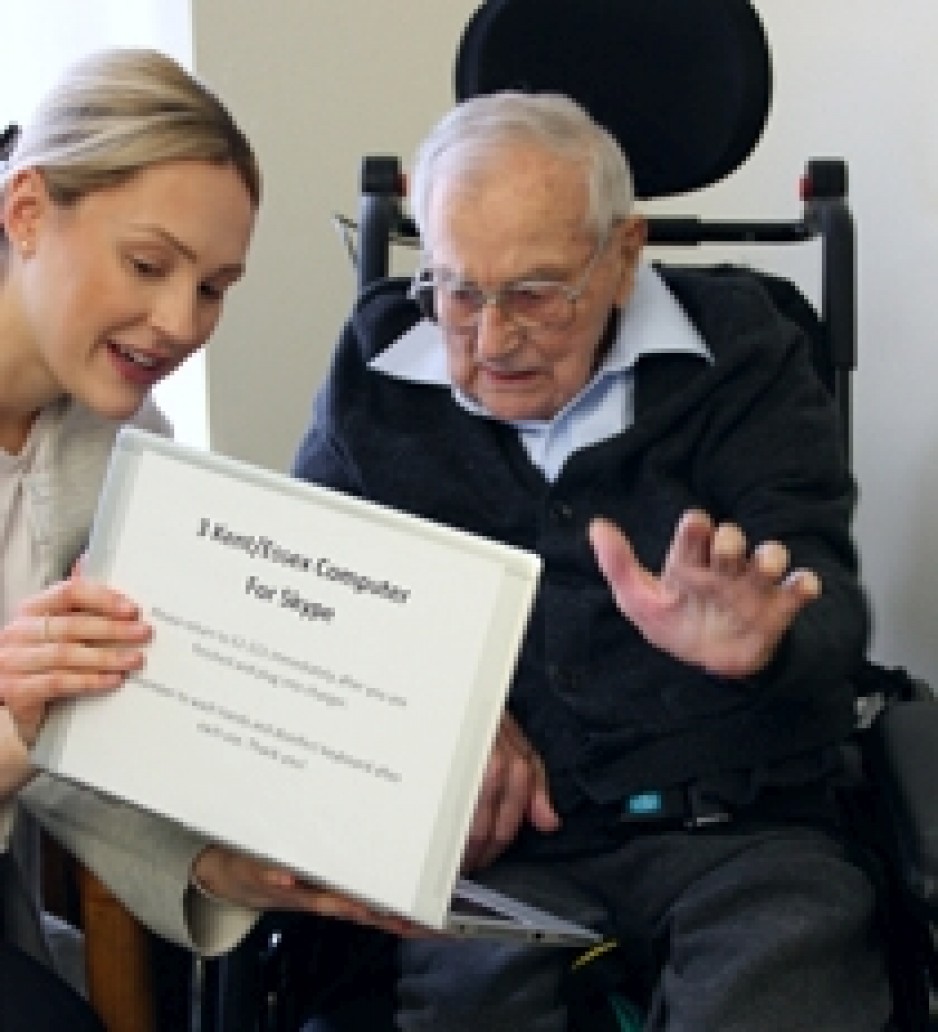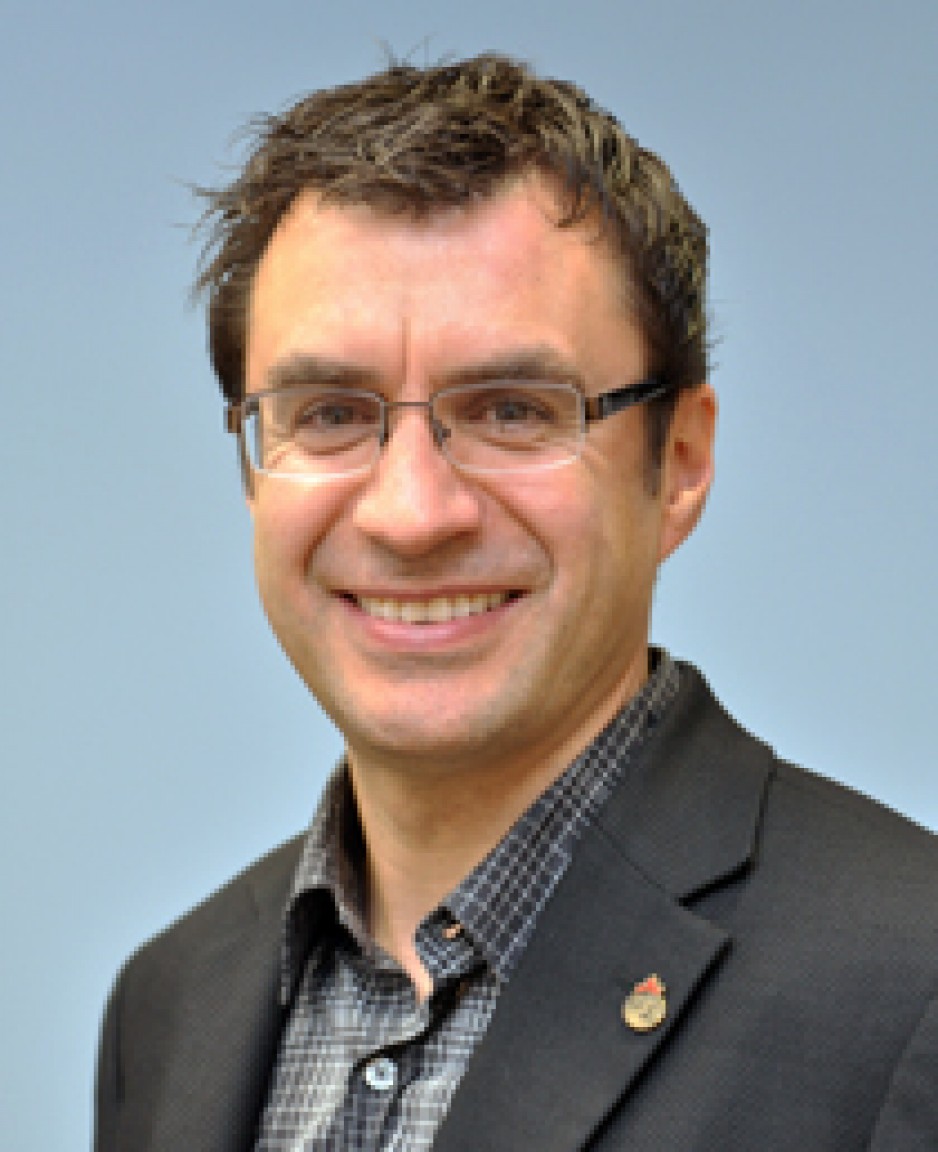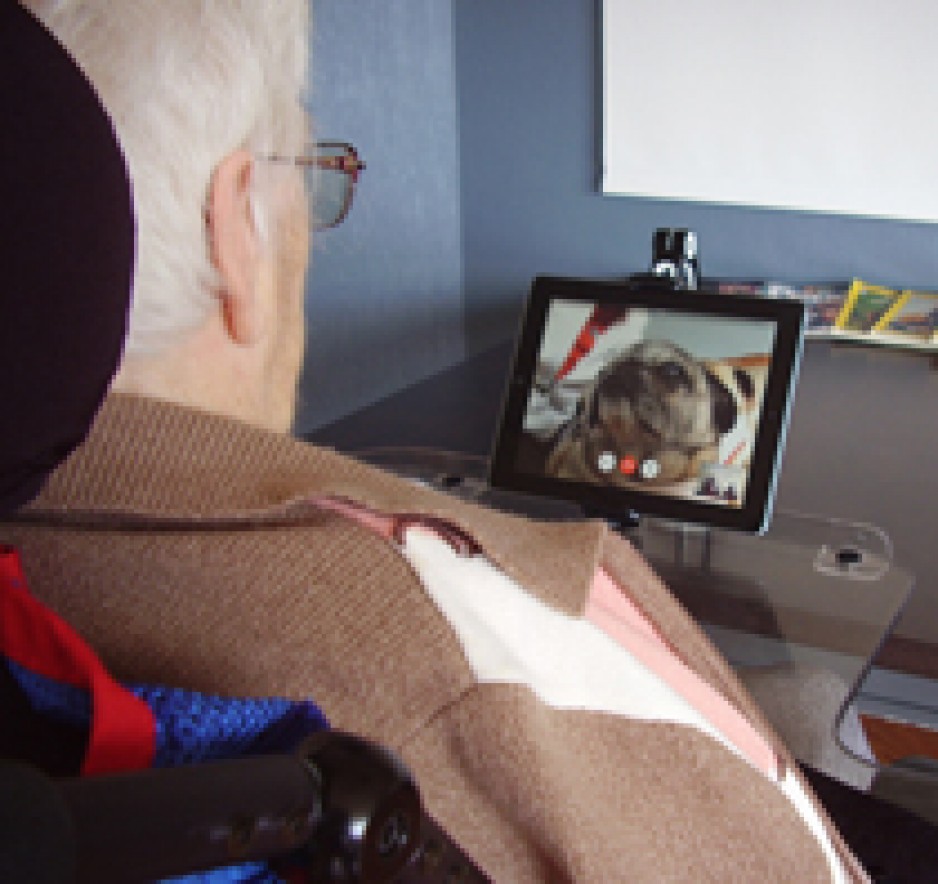Virtual patient care – the COVID-19 silver lining
In today’s digital society, it should be common place to talk to your doctor or attend a clinic appointment from the safety and comfort of home. Yet in health care, virtual technology has been virtually lacking. Until now.
Across St. Joseph’s Health Care London, teams are rapidly and creatively taking advantage of what they see as the COVID-19 silver lining – the impetus to fast forward and more optimally capture the benefits of virtual or remote patient care.
In April 2021, 50-60 percent of all registered visits at St. Joseph’s were virtual, a jump from about five per cent pre-pandemic. The daily average is currently about 1,000 virtual visits compared to about 200 a day pre-pandemic.
“Our response to COVID-19 has helped us refocus our priorities to ensure our patients, many of whom have special health needs, keep connected with their health care team,” says Dr. Sarah Jarmain, Co-Chair of St. Joseph’s Quality Council and a member of the team implementing virtual care across St. Joseph’s.
The organization is just at the beginning of this journey, says Glen Kearns, Integrated Vice President, Diagnostic Services and Chief Information Officer. “We will continue to engage patients and clinicians in planning and how we evolve and adapt to this new way of providing service to some patient populations."
Without leaving home, many St. Joseph’s patients are receiving care, education and therapy through various virtual technologies. They include phone-based counselling and assessments, Ontario Telemedicine Network and a customized version of Cisco Webex appointments, online resources, e-newsletters, and more. All are being tapped with excellent results and appreciative feedback, “which tells us this is a model of care we must pursue post COVID-19,” adds Dr. Jarmain.
This doesn’t minimize the struggle of those patients we haven’t been able to be see during the pandemic, says Dr. Jarmain, “but what teams have been able to do very quickly has been remarkable.”
Virtual mental health care for veterans
One unique population is veterans. Psychiatrist Dr. Don Richardson is Medical Director of St. Joseph’s Operational Stress Injury Clinic (OSI Clinic), a program that provides mental health supports for veterans, Canadian Forces members and the RCMP. He has seen benefits of the OCS Clinic’s team of psychiatrists, psychologists, social workers and nurses in their London, Toronto and Hamilton sites incorporating virtual care into daily practice during the pandemic.
“Most of my patients have responded well to the use of both high-tech, secure, videoconferencing and the low-tech, but reliable, telephone for appointments,” says Dr. Richardson. “It’s been an important tool in ensuring we can continue to provide our patients care at a time when they are under added stress from the pandemic created by job loss, financial worries, family strain and increased isolation.”
Involving family caregivers in therapy is also enhanced when care is delivered virtually as caregivers can participate in sessions or be close at hand to answer questions and provide insight into the patient and family’s needs.
While research shows psychotherapy and mental health symptom management are effective through virtual care, Dr. Richardson admits there are challenges.
“Establishing trust with patients is key to providing effective treatment, something that’s harder to do virtually,” says Dr. Richardson. “As clinicians, most of our training and experience is in face-to-face assessment and treatment. When using videoconferencing, the quality might not always be clear, or if delivering care by phone, we have to rely on more subtle clues to what’s going on with the patient such as changes to their voice. That’s difficult to do, especially with a new patient.”
For mental health patients, it may also be difficult to transition back to face-to-face therapy once social isolation restrictions have lifted. Accessing care virtually may reinforce avoidance behaviours typical to someone with mental illness such as post-traumatic stress disorder and anxiety. Sometimes, coming for therapy is the only time that patient leaves their house in a week.
"Emergence of virtual care is something physicians have been asking about for years. COVID provided the impetus to finally make it happen. While it is not without enormous effort on the part of our leaders at all levels, the rapidity with which we have been able to transform some forms of care, and provide care where it is needed, provides us with examples that perhaps we can enact change more quickly than we traditionally have done in health care. Virtual care is not appropriate in every circumstance, but it will emerge as a new tool in the service of patients."
Read more the transition to virtual care by St. Joseph's OSI Clinic.
Embracing the opportunities
Staff and physicians at St. Joseph’s are not only embracing the opportunities to incorporate virtual technology in care, they are excelling.
“There has been outstanding dedication and ingenuity by staff and physicians in finding new ways to serve patients at this unprecedented time,” says Tom Janzen, Integrated Chief Medical Information Officer for St. Joseph’s. “And we will be stronger for it.”
While not all patients are having their needs met remotely, there are many highlights of virtual patient care at St. Joseph’s:
- Rehabilitation: Patient therapy programs in the Rehabilitation Program at Parkwood Institute Main Building are being delivered through videoconference.
- Stroke: The Community Stroke Rehabilitation Team and Comprehensive Outpatient Rehabilitation Program are visiting patients and their caregivers through videoconferencing. Patients are progressing with their rehab using face-to-face virtual appointments, participating in group sessions and receiving stroke prevention education from the comfort of their homes.
- Endocrinology: The Diabetes Education Centre, diabetes and osteoporosis clinics, with few exceptions, have moved to a predominantly virtual care model.
- Cardiac rehab: The Cardiac Rehabilitation and Secondary Prevention Program team, including rehab trainers, dietitians, nurses, psychologist, social worker and cardiologists, are engaging with patients through interactive telephone coaching sessions, telemedicine, video technology and a variety of online education resources. Read how they are doing so and how patients are benefitting.
- Pain management: In the Pain Management Program, each physician has moved their practice to phone or videoconferencing visits, as have the allied health team, including nurses, psychologists, occupational therapists, physical therapists, a social worker, and clinical pharmacist. Virtual group sessions, e-newsletters and email support are among other new ways pain management patients are accessing care. The program has also joined with other pain programs that make up the Ontario Chronic Pain Network to create and offer a weekly schedule of webinars for patients across Ontario to help them cope with pain during COVID-19.
- Inpatient programs - veterans, geriatrics, complex care and rehabilitation: At Parkwood Institute Main Building, patients, residents and their family members are finding comfort in virtual visits via video calls. Members of interdisciplinary teams provide support by partnering with individual families to facilitate – arranging schedules, booking a laptop or iPad and sitting with the patient/resident to make the calls. Seeing the delight, relief, laughter and tender moments exchanged between patients, residents and families has been uplifting for staff to witness.
- Allergy: The Allergy and Immunology Program for allergy and asthma patients have moved almost entirely to a virtual model of care. Patients are seen via telephone and videoconferencing to ensure continuity of care while also leveraging the relationship with primary care physicians to maintain treatments. One physician is participating with colleagues across Canada in virtual food challenges to help ensure the window of opportunity of food introduction isn’t missed in young children. Missing the window can increase the risk of food allergy in a susceptible child.
- Chronic obstructive lung disease: The COPD and Pulmonary Rehabilitation Program team, including respiratory therapists, rehab trainers, dietitian, social worker, nurse practitioner, and respirologists, are providing continued care and programming using interactive telephone coaching sessions, telemedicine, and weekly email communications to patients that include video technology. The nurse educator has begun group education by telephone, which allows for continued group interaction and support. A group virtual exercise program has also launched via WebEx.
- Long-term care: At Mount Hope Centre for Long Term Care, residents are experiencing virtual entertainment to stay engaged and entertained. Live music is happening via Skype, which is also connecting residents with loved ones thanks to staff who enable these important interactions. Read how 93-year-old Hilda Libal was able to attend her grandson’s wedding virtually.
- Pet therapy: Therapeutic recreation staff at Parkwood Institute Main Building are ensuring patients can still enjoy their weekly pet therapy through virtual visits with their favourite St. John Ambulance therapy dogs. The dogs provide a sense of normalcy, comfort and excitement to their week.
- Hand and upper limb: Physicians and therapists in the Roth McFarlane Hand and Upper Limb Centre are assessing and consulting with patients virtually using video and phone. Through video, therapists are able to see patient movements, limitations and restrictions and recommend care they can do at home to continue mobility and healing.
- Ear, nose and throat: To move care forward, Otolaryngology - Head and Neck Surgery runs a clinic virtually three times a week, where patients are triaged and seen through videoconferencing.
Care and compassion bridges distance and space
No loss of value - John Hodgkinson
When the pandemic began, John Hodgkinson joined a group education session with others living with chronic obstructive lung disease (COPD). But not to worry – John was the only person in the room. All were tuning in by phone.
Not only does the 70-year old see no downside to this virtual gathering, he thinks it’s “fabulous.”
Diagnosed with chronic obstructive lung disease(COPD) about 10 years ago, John was referred to St. Joseph’s COPD and Pulmonary Rehabilitation Program not long before the pandemic struck. He attended two group education sessions in person before non-urgent care was put on hold. Since then, he has had several group education and doctor visits by phone. Some COPD patients are also taking part in a group virtual exercise program by Webex, with patients and rehab trainers interacting from their own homes and the medical team supervising from St. Joseph’s Hospital to ensure patient safety.
“There has been no loss of value,” says John of the virtual group education sessions, adding that the informality of the sessions actually makes him feel more comfortable to ask questions. He also appreciates avoiding the trek into the hospital, parking, and inconveniencing his wife, who has to drive – an ordeal that would take over his day.
“They stumbled upon something extremely good and efficient. I see nothing but positives.”
Fighting the storm - Marie-France Vermette
For Marie-France Vermette, a daily swim of 140 laps in the pool was helping to keep chronic pain in check. When the world stopped and the pool closed with the pandemic, her pain flared.
“I was in full blown crisis. For people in chronic pain, with depression, with anxiety - many things you may rely on to get through the day was taken away with the pandemic.”
A patient of the Pain Management Program at St. Joseph’s Hospital, Marie-France says her care team didn’t miss a beat. She has been receiving one-on-one therapy with her social worker by phone as well as group education sessions by Webex led by the social worker and a psychologist. Her pain management physician and pharmacist are also in touch by phone, and regular emails and e-newsletters from the program provide tips and resources for self- management.
The technical support from St. Joseph’s and the smaller groups taking place by Webex have been excellent, says Marie-France. While she misses the informal peer support and social connections that happen before and after the in-person groups, the sessions overall, she says, have been invaluable.
“We are all fighting this storm in our little boats, but all our little boats look different. And when we come out of this, all our boats will be weathered differently too. I appreciate that the team ensures everyone in the group is there and feels included… I don’t feel the ball has been dropped.”
An overwhelming sense of relief - Beth Miller
In early January, at just 39, Beth Miller experienced a hemorrhagic stroke, or brain bleed, that left her with significant mobility loss on the right side of her body. For this athlete and mother of three, the aftermath was devastating.
After spending three weeks as an inpatient at St. Joseph’s Parkwood Institute, Beth was discharged home and began receiving care through St. Joseph’s Comprehensive Outpatient Rehabilitation Program. But after just one in-person visit with a physiotherapist, the pandemic struck, putting a hold on Beth’s future visits for therapy.
“I remember feeling scared and not knowing what to do next.”
But St. Joseph’s rehabilitation staff were quick to reach out to Beth with the option of continuing her care virtually. With an overwhelming sense of relief, Beth jumped at the opportunity. Over the next several weeks, physiotherapist Darlene Vandesompele worked with Beth over videoconferencing software, providing detailed exercises, videos and demonstrations to help her gain strength and use of the right side of her body.
“It was a great feeling to be supported and have check-ins about my care,” says Beth. “During a time of isolation, I was not isolated from my physiotherapy. I just can’t say enough good things. I feel very grateful.”
A virtual lifeline - Robert Jenkinson
When Robert Jenkinson began his virtual care sessions with St. Joseph’s speech language pathologist Debra Medzon, he couldn’t talk. A faint whisper – almost inaudible - was the extent of his verbal communication.
After suffering a stroke in March 2020, Robert spent weeks receiving care in the Stroke/Neurological Rehabilitation Program’s inpatient unit at Parkwood Institute. As COVID-19 began to ramp up, the 77-year-old was discharged and transitioned to St. Joseph’s Community Stroke Rehabilitation Team. Then everything stopped.
“It was a stressful time,” says Janet Jenkinson, Robert’s wife of 52 years and his primary caregiver. “When we heard about the opportunity for virtual therapy sessions, we were grateful that someone had reached out to us.”
Through videoconferencing technology, Robert – with the help of his wife – began receiving speech language therapy virtually. As the therapy progressed, he slowly regained the use of his voice. Today, Robert is speaking clearly, in full sentences, and his voice continues to get stronger.
“It’s been a virtual lifeline,” says Janet. “If I was the sole caregiver to help Robert with his speech, the outcome may have been quite different.”


